Installing NetWare NFS 1.2C on NetWare 3.12
This page covers installing NetWare NFS v1.2C on NetWare 3.12 (actually 3.2 but that doesn't make any difference).
Contents
- Tools
- Installing
- Configuring
- Installing the latest patch
- Connecting from Windows
- Connecting via FTP
- Connecting from Linux
Tools
Things you'll need to follow along:
- A VM with NetWare 3.12 or 3.2 (3.11 should be fine too)
- TCP/IP configured (See: Configuring TCP/IP on NetWare 3.12)
- A copy of NetWare NFS 1.2C (it comes on a single serialised floppy disk)
Note that NetWare NFS is a paid-for add-on product. It doesn't come with NetWare and it was never made available as a free download. If you don't already have a copy you might be able to find one on ebay.
To get the most out of NetWare NFS you'll also want a copy of the Novell NetWare NFS Supervisor's Guide which should have come in the box with your copy of NetWare NFS. It convers how to configure and operate the thing as well as the various things you can and can't do.
Installing this product creates a number of users and groups. If you've got Netsync running you'll probably have to do some work later to send the new users and groups into NDS.
Installing
Before proceeding make sure DOS is redident in memory as files need to be copied into the startup DOS startup directory. If you've previously run the UNLOAD DOS command you'll need to down and reboot your server to get DOS back. If this command is in your AUTOEXEC.NCF file you'll need to temporarily remove it until installation has completed.
If you currently have the NFS Gateway installed there is some additional configuration required. This is covered on page 2-7 of the manual (Using Other NFS Products).
As is usually the case with these things, we start off by running LOAD INSTALL
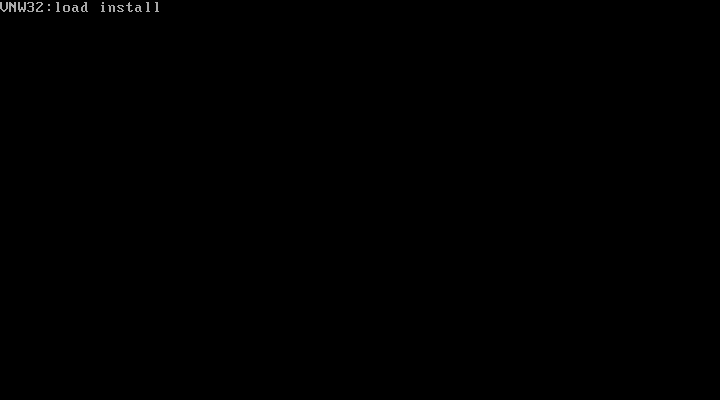
Select Product Options
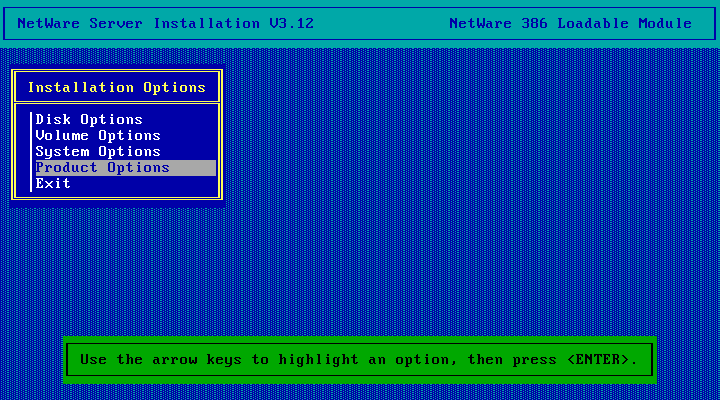
Press the insert key
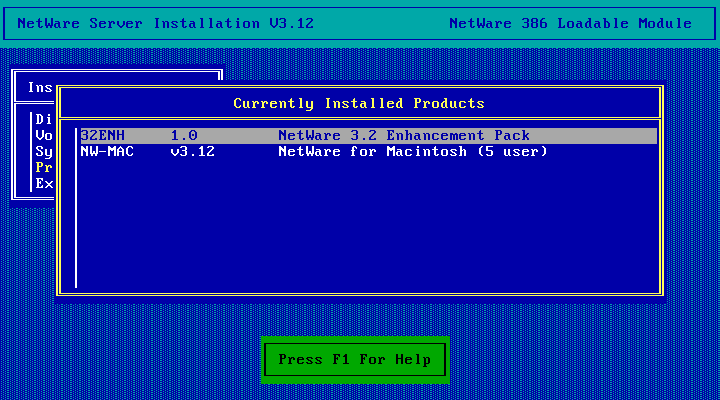
Insert the NetWare NFS floppy disk / mount the disk image then hit Enter
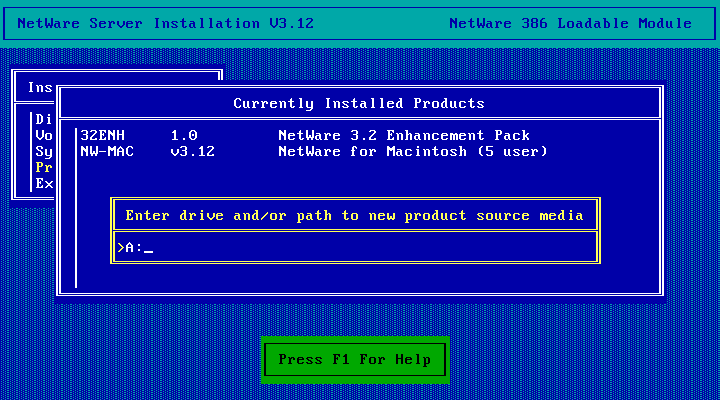
Apparently there is a readme file on the floppy disk you might like to read later. Hit escape.
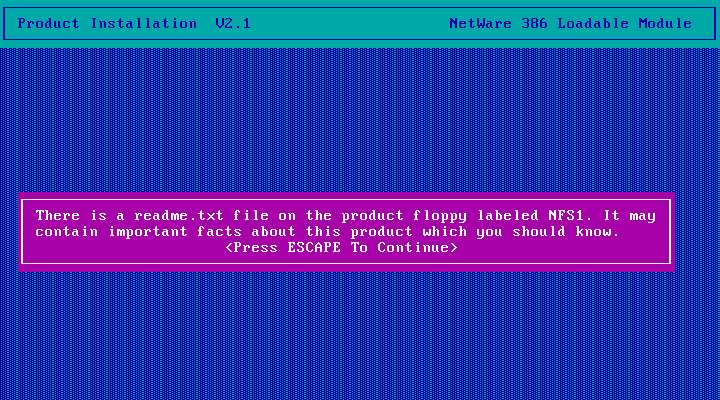
Choose No - we'd like to continue installing.
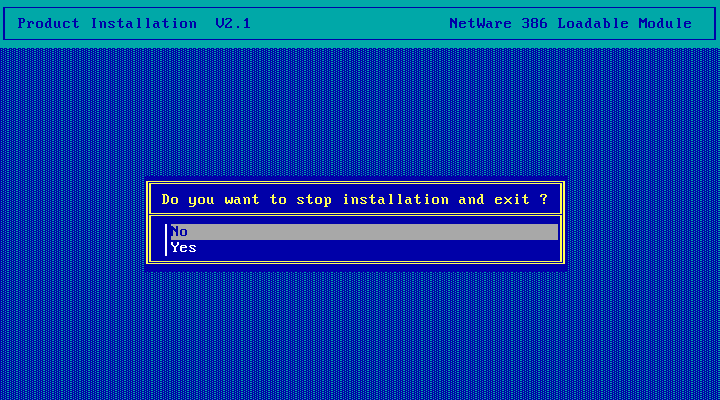
Enter hostname. Apparently this only happens if one hasn't already been configured somewhere else.
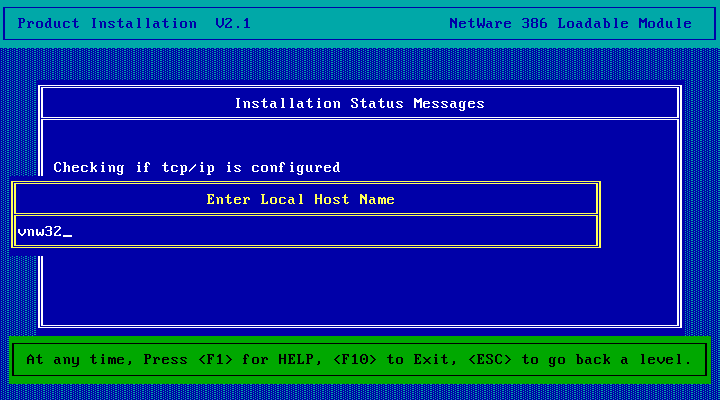
Enter the location where SERVER.EXE lives. For me this defaulted to just C: which is not correct. Note that you don't need the trailing slash (the installer will add one regardless of whether one is there)
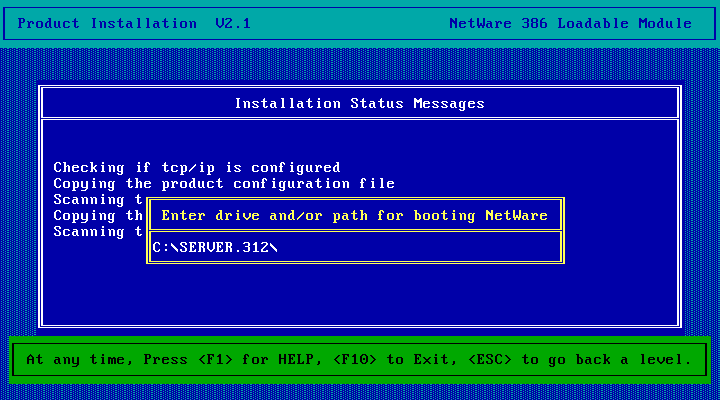
Copying files...
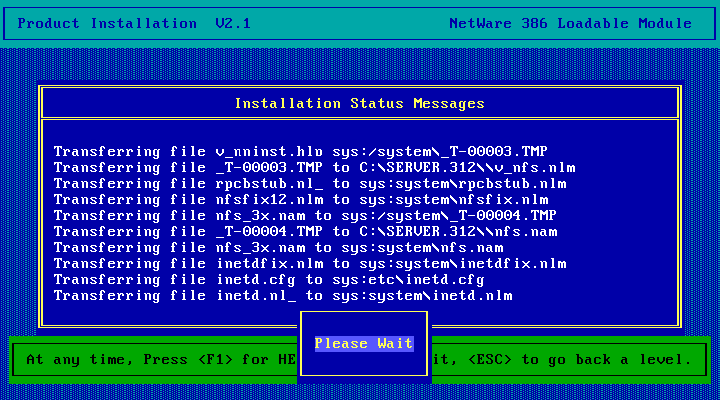
Done! Hit scape
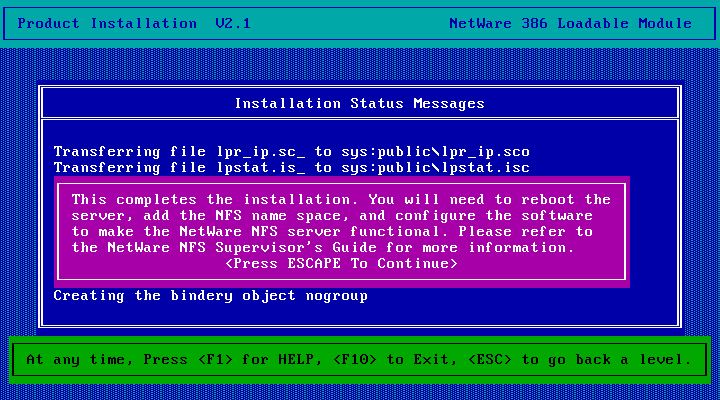
Hit escape again...
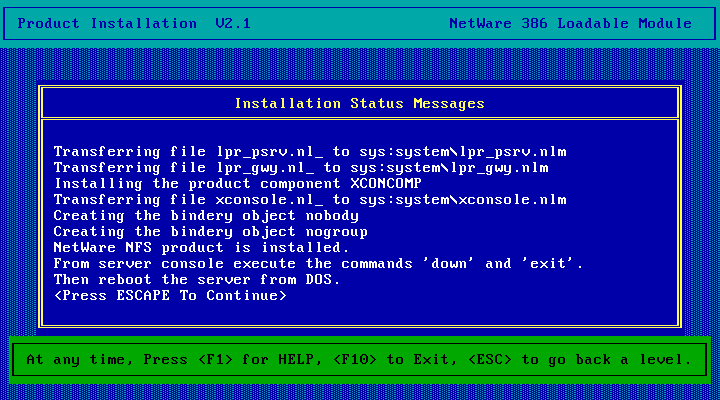
NFS 1.2C is installed! Hit escape twice and choose yes to exit
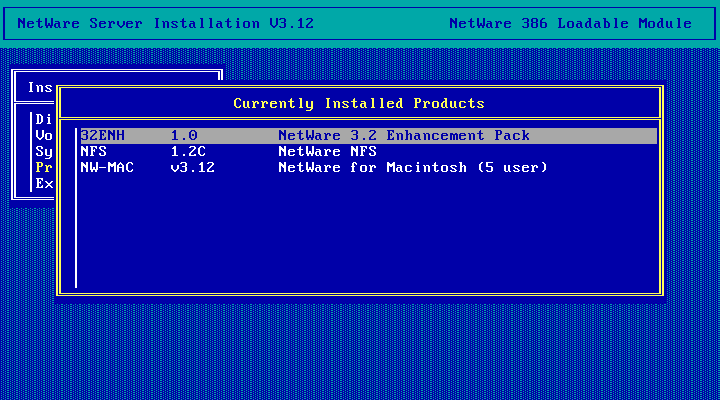
Then DOWN the server and EXIT to DOS
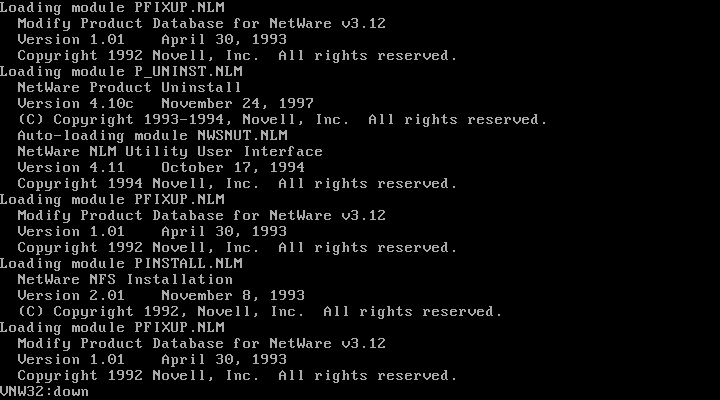
When the server started back up I got this screen. Just hit any key to continue.
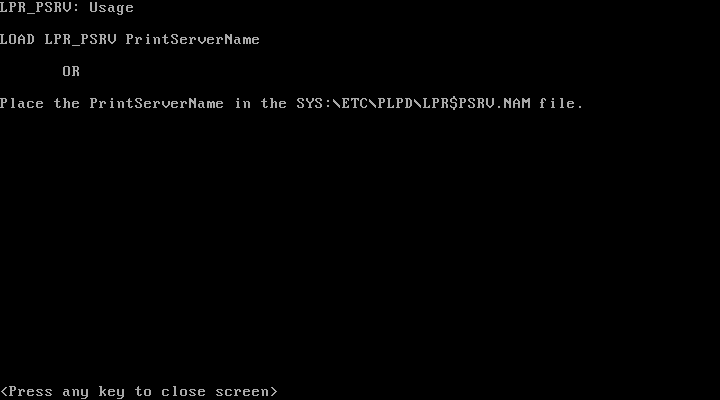
And the hit any key to continue message goes away but we don't get the server console. Thats because we're actually on the NetWare LPR Print Server console. The shortcut key to switch between
netware consoles (Alt+Esc to cycle, Ctrl+Esc for a list) doesn't work with virt-manager on windows (what I'm using) so I had to switch to an old linux laptop to do this.
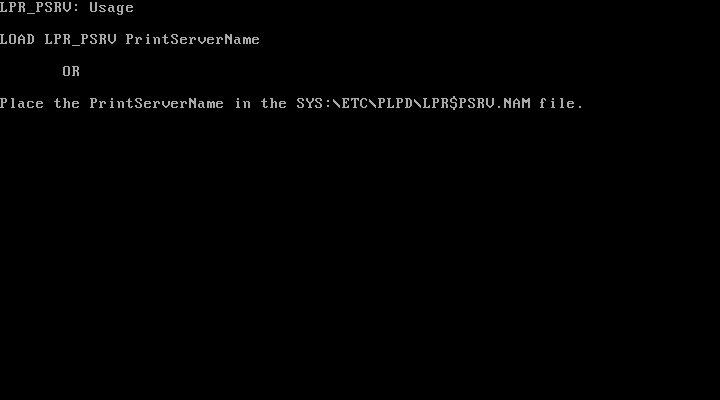
Over on the server console there was this prompt! This wasn't in the manual! Looks like XCONSOLE was installed at the same time. IIRC this is pretty much a telnet version of RCONSOLE and it wants a password set. If you've got LOAD REMOTE already in your AUTOEXEC.NCF for RCONSOLE you probably won't get this prompt.
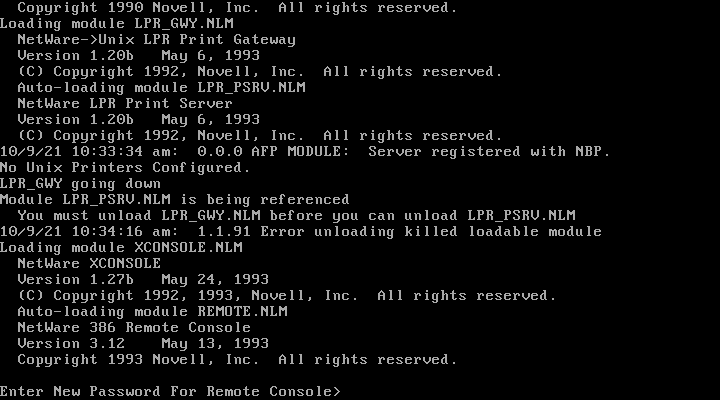
At this point I got a bit distracted and had a look at XCONSOLE. Its pretty neat but not really relevant to getting the NFS server going.
Back at the server console. Time for some configuring! First up, run LOAD NFS
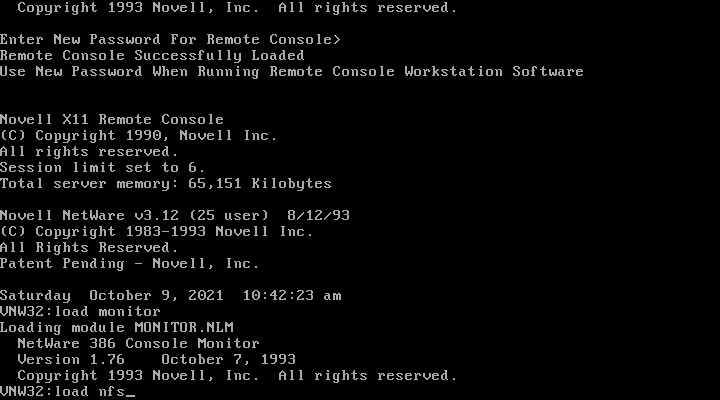
And its already loaded. Good - that means we don't need to add it to STARTUP.NCF. Now we can add the namespace to the SYS volume (and any others that will be storing NFS files) with ADD NAME SPACE NFS TO SYS
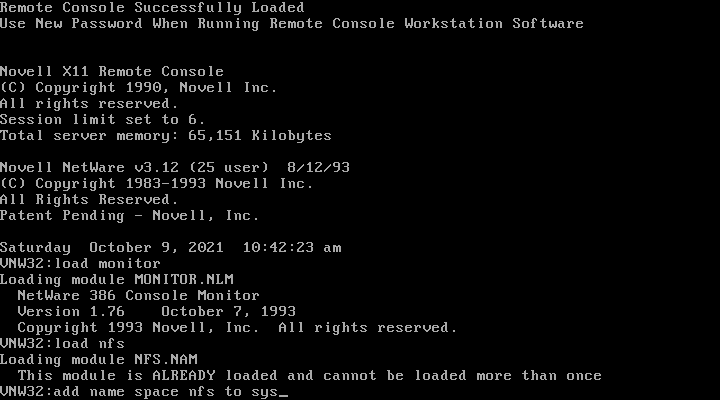
And I got an error: 1.1.39 Cache memory allocator out of available memory
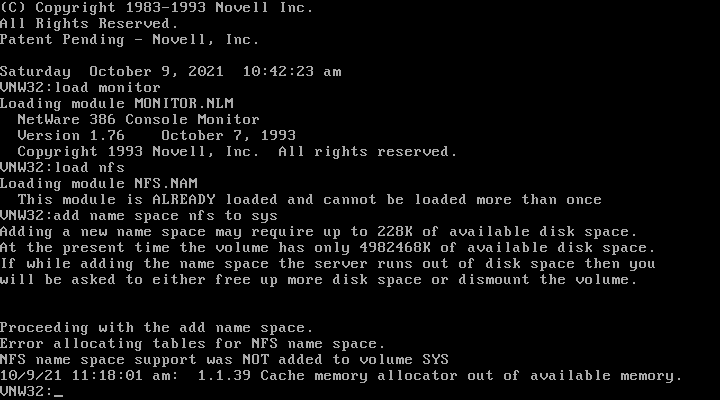
So the error is a bit of a tricky one. A lot of people recommended back in the 90s to install patches, etc. I'm running NetWare 3.2 here so there aren't really any additional patches to apply.
What did fix the problem for me was removing the set auto register memory above 16 megabytes=off command from STARTUP.NCF and the register memory command from AUTOEXEC.NCF. These were required when I initially setup NetWare 3.12 in order for it to see more than 16MB of RAM. NetWare 3.2 seems to be recent enough to see the whole 64MB on its own so it doesn't need them (I assume fully patched Netware 3.12 is the same). Problem solved!
While I was fixing the problem I also added LOAD NFS.NAM to STARTUP.NCF as it really ought to be loaded before the SYS volume is mounted if that namespace is going to be added to SYS:.
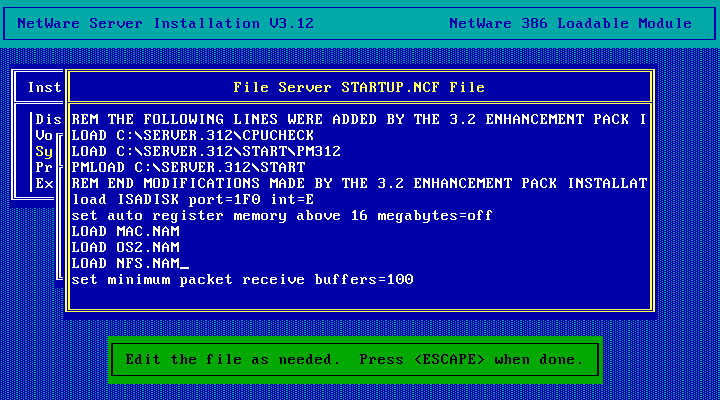
Configuring
NetWare NFS 1.2C is now installed. What comes next is configuring the product to actually do something!
We start off by running load nfsadmin -install at the server console:
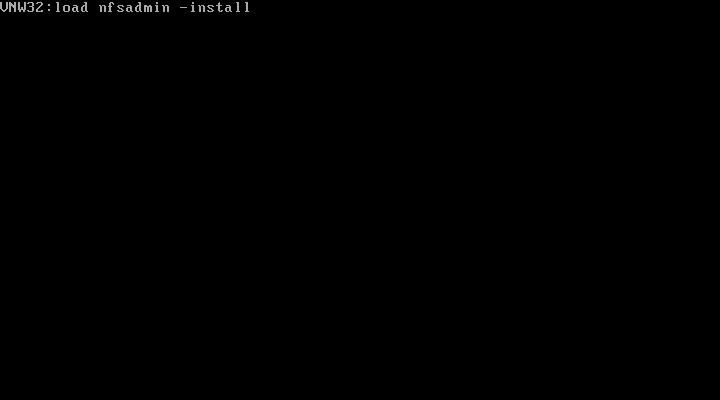
And get asked if we want to modify the NFSUSERS table. Choose Yes.
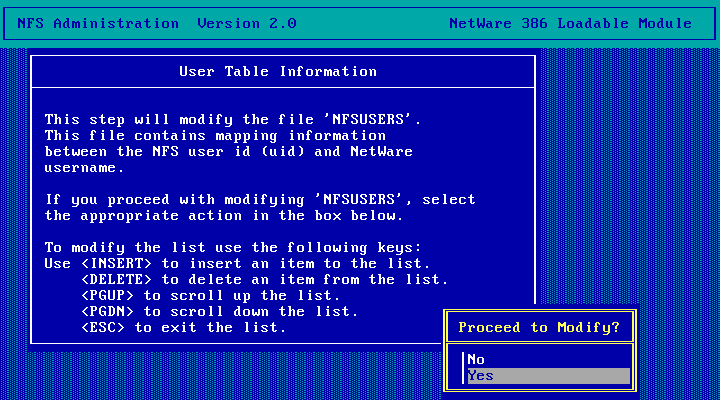
Here we're mapping NFS (UNIX) user IDs to NetWare usernames. By default its mapping user ID 0 (usually root) to supervisor. If you want to add any more, hit insert.
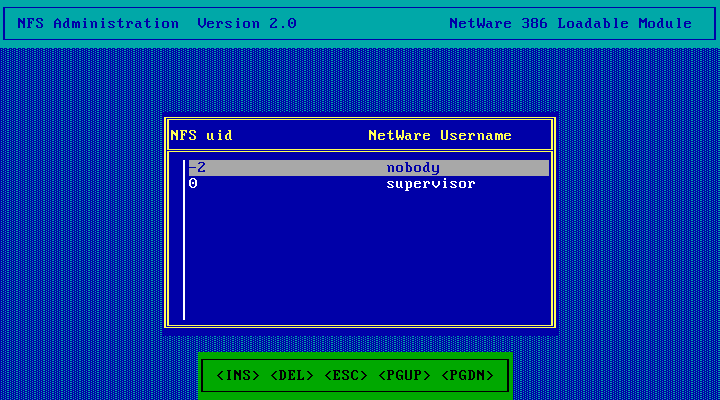
Then enter the NFS User ID to add and hit enter. You'll probably want these to map user IDs on whatever unix systems you're mounting volumes on.
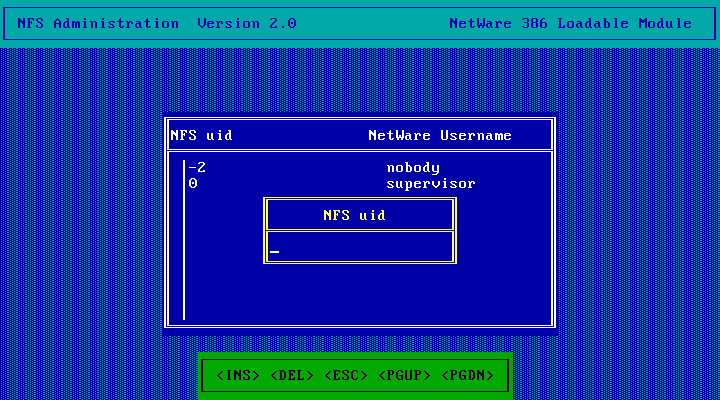
Then enter the NetWare username it should map to and hit enter. If the netware doesn't already exist at this point it will be created.
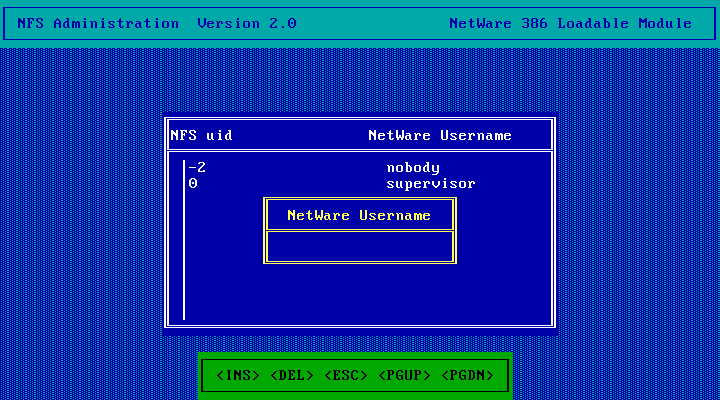
And repeat the process for any other user Ids you're adding. When you're done adding users hit escape to continue.
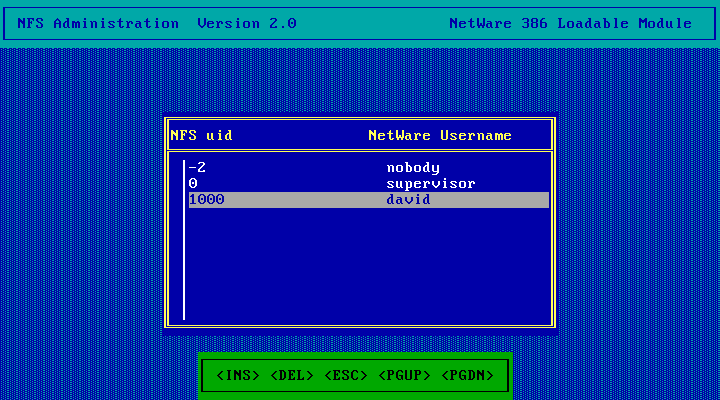
And choose to save.
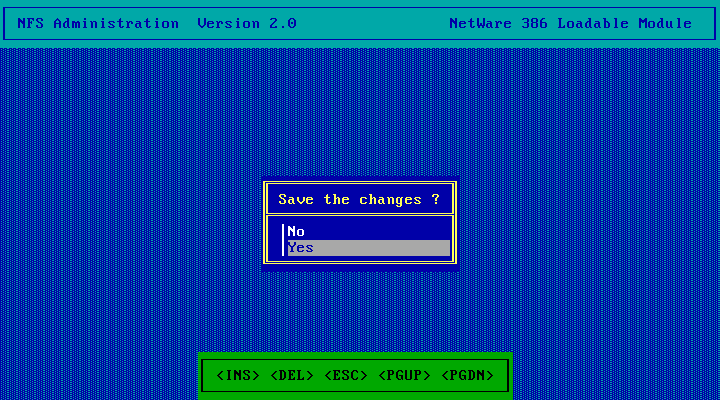
Then you get to modify the Group Information Table! Choose yes.
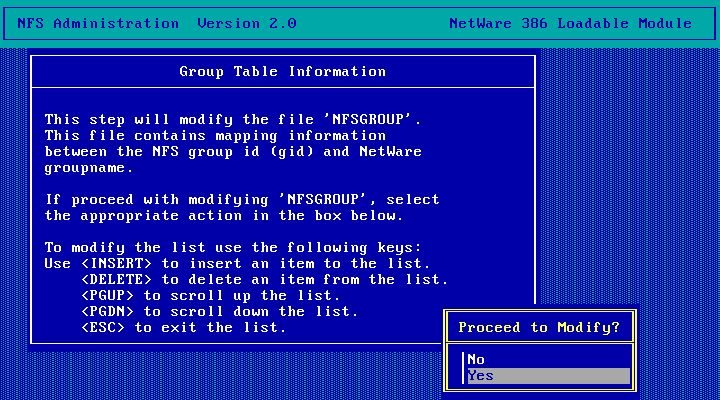
And here we can map NFS Group IDs to NetWare Groups. The process is the same as for the UserID Mappings - it insert to insert a new entry. As with users, if the chosen NetWare group doesn't exist this process will create it. Once you're done hit escape to continue and choose Yes to save.
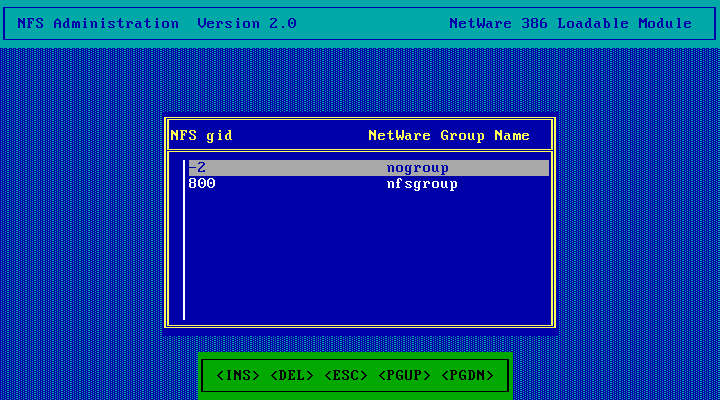
Next up: HOSTS. Choose Yes to modify.
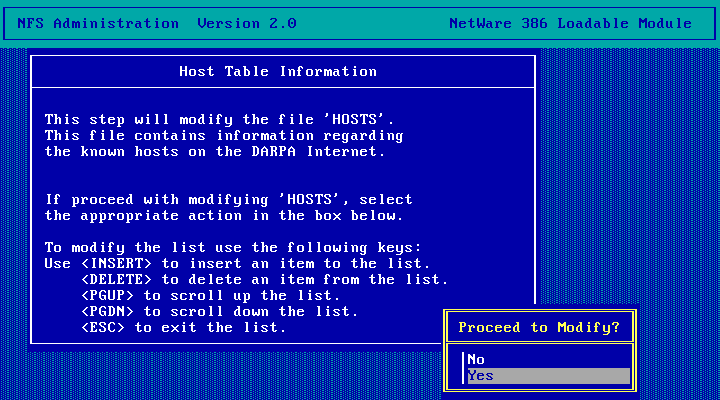
And here you can add entries to the hosts file. Here you need to add the IP address of each host
that will be allowed to mount NFS exports on this NetWare server. So hit insert.
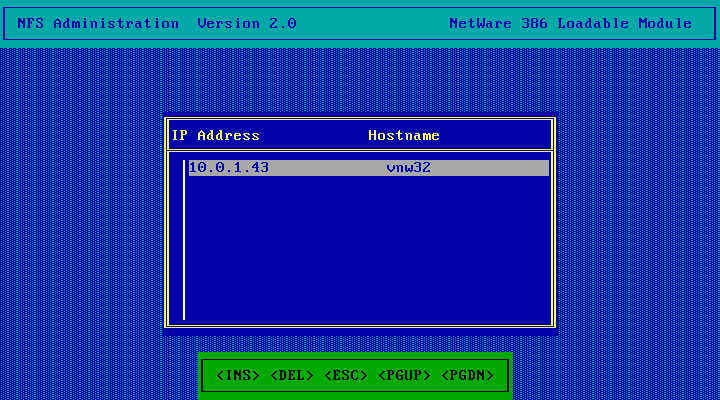
And enter an IP address
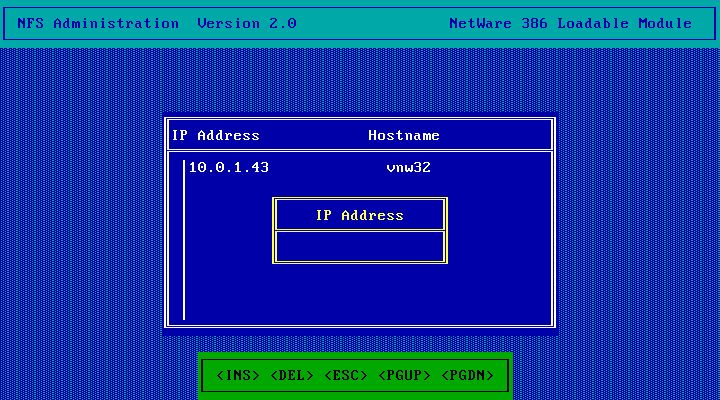
then a hostname
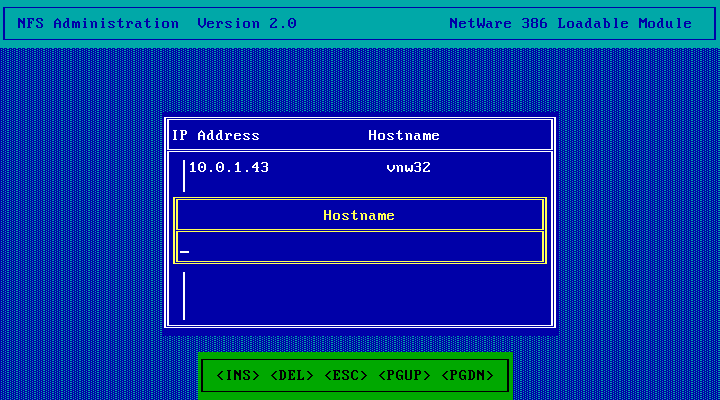
I've added IP address of two machines I'm going to try connecting from. When you're done hit Escape and choose Yes to save.
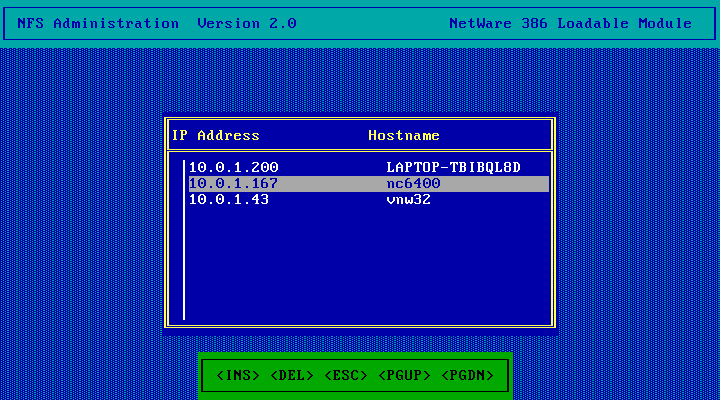
Next we're going to edit ther EXPORTS file. Choose Yes to continue.
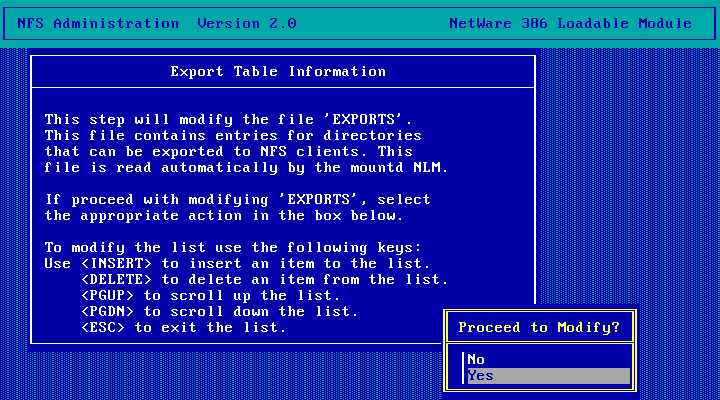
No defaults here! press insert to add one.
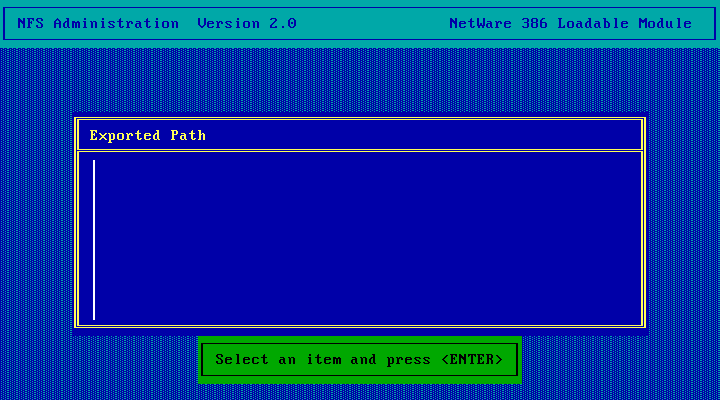
And enter the directory you'd like to export. Note that the login, public, mail and system directories in the SYS volume can't be exported. Directories you're exporting must already exist (it won't be created automatically). I created a directory called export from a DOS workstation that I'm going export so I'm entering /sys/export. If you want to export an entire volume (besides sys) you can enter /volume-name.
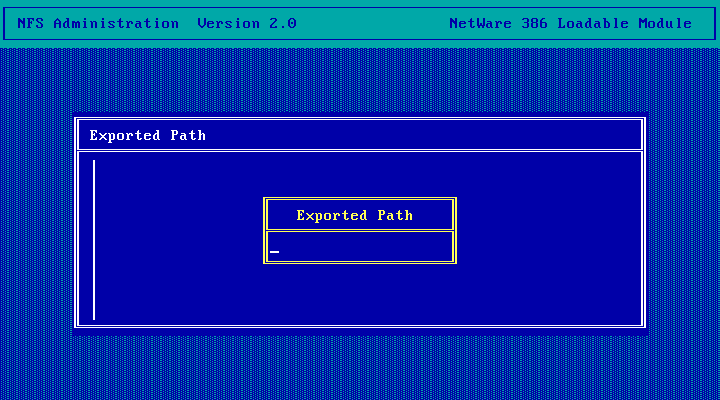
Export added! Select it and hit enter to configure it.
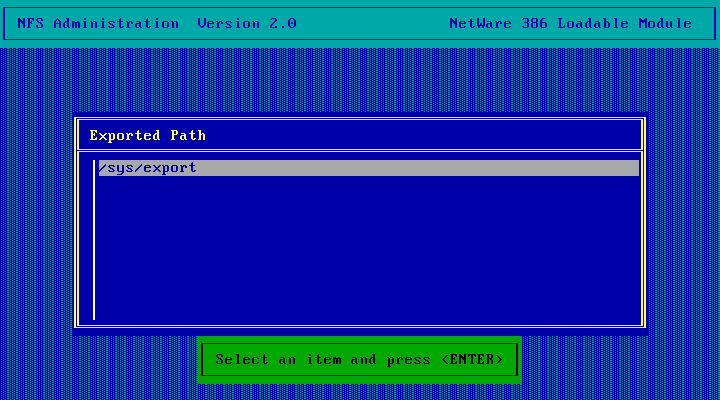
Here we need to set the trusted hosts. Only hosts that were previously added to the hosts file can be used. If multiple are required separate them iwth a space or colon. If more than 40 characters need to be entered you've got to come back later and edit SYS:\ETC\EXPORTS with a text editor.
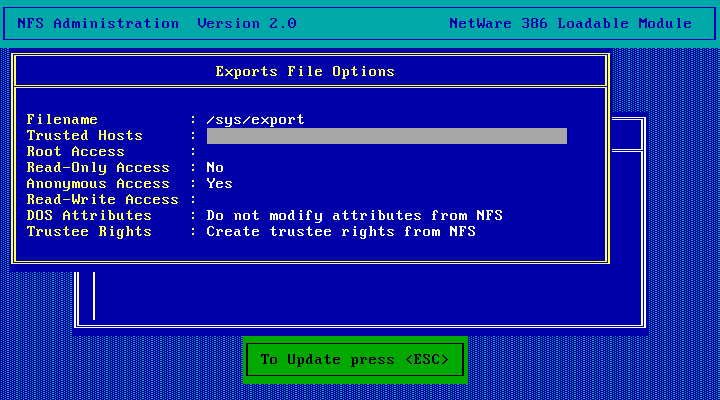
The Root Access field is also a list of hostnames with the same rules as for Trusted Hosts. In this field you list the hosts where the root user should be mapped to the supervisor account. For any hosts not listed, root will get mapped to nobody (root squash).
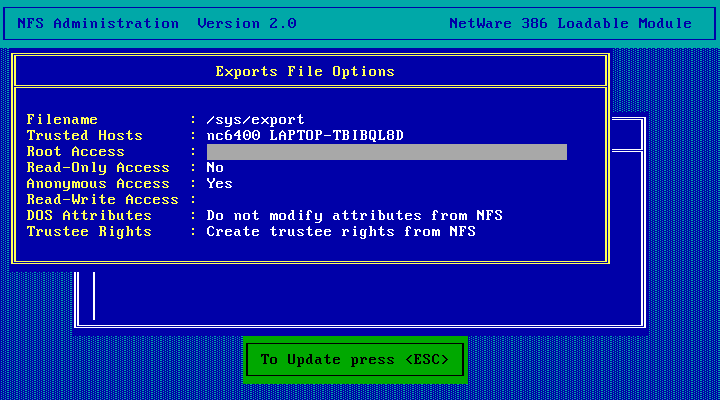
If you set the Read-Only Access field to Yes users on trusted hosts will only get read-only access regarldess of user account.
The Anonymous Access field enables access by the NOBODY user and NOGROUP group.
The Read-Write Access field stores a list of hosts that should override the Read-Only Access setting and get read-write access. Same rules as the other hostname fields.
The other fields control whether UNIX clients change DOS attributes (no by default) and whether they can change permissions (yes by default)
Once you're done, hit escape.
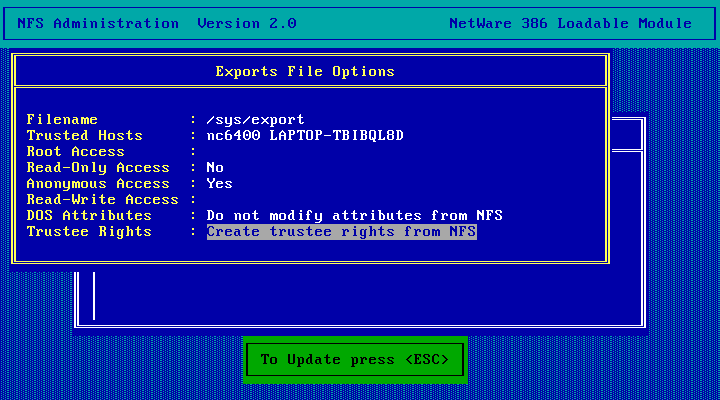
And hit escape again and choose yes to save changes.
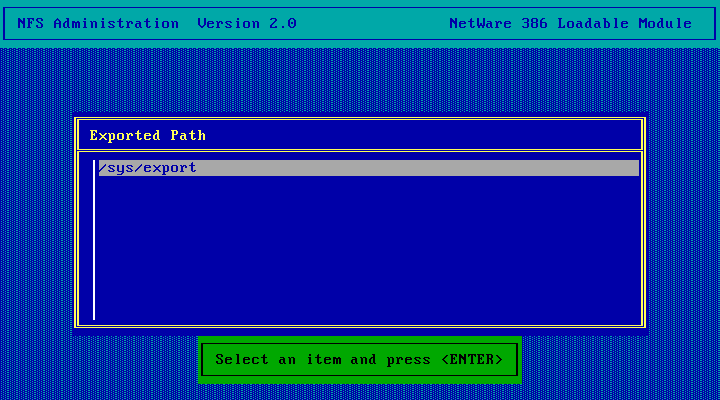
Then its on to setting file attributes. Choose Yes.
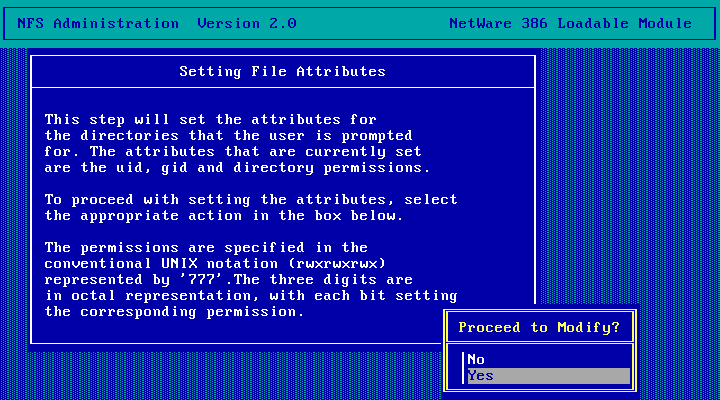
And we get the list of exports again. Hit enter to select an export.
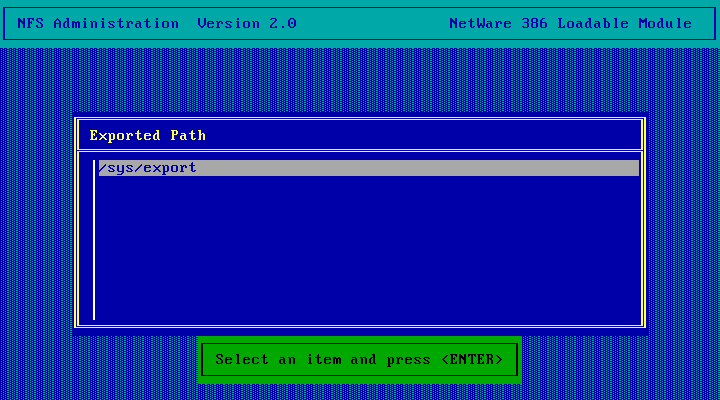
This is basically just doing a chmod and chown to the directory, optionally recusively. I'm setting my export to 777 for now as I really just want to see if this works and don't want permissions to get in the way.
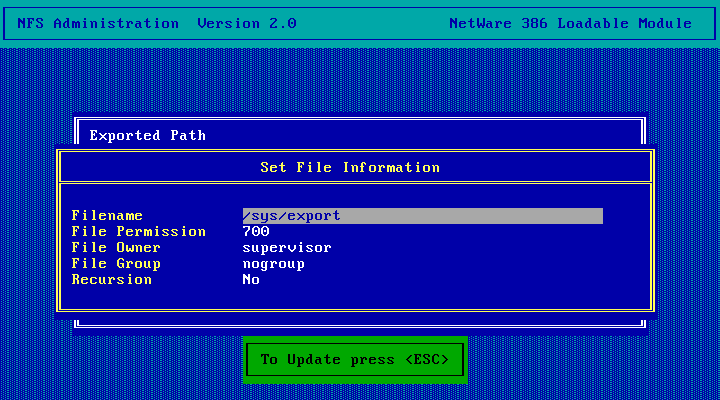
When done hit escape and choose Yes to save changes.
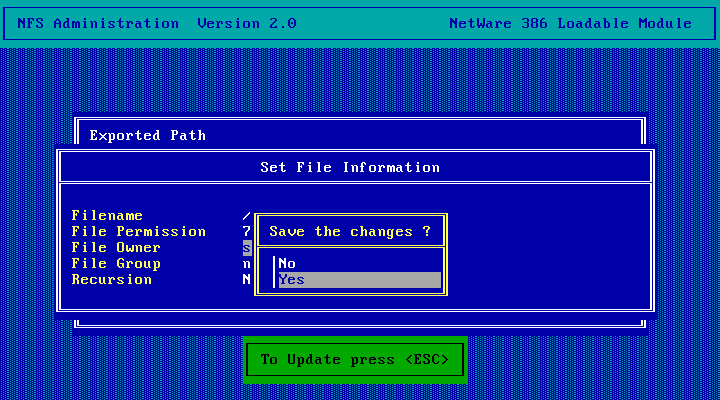
When you're done setting permissions, hit escape to continue.

On to the LPR Print Gateway! I think my printer may support LPD but if it does I'd rather set it up on NetWare 4.11 so my goal here is to configure LPR enough that it doesn't display that error on startup. Choose Yes.
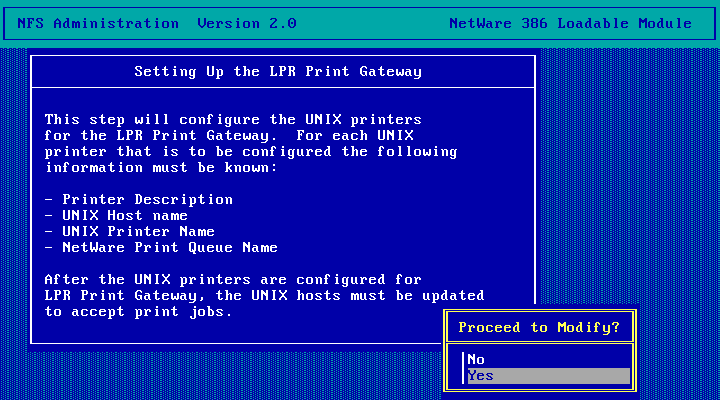
And this is what it was complaining about on startup - it doesn't have a name. If we give it one it should stop complaining. I'm calling mine LPR32.
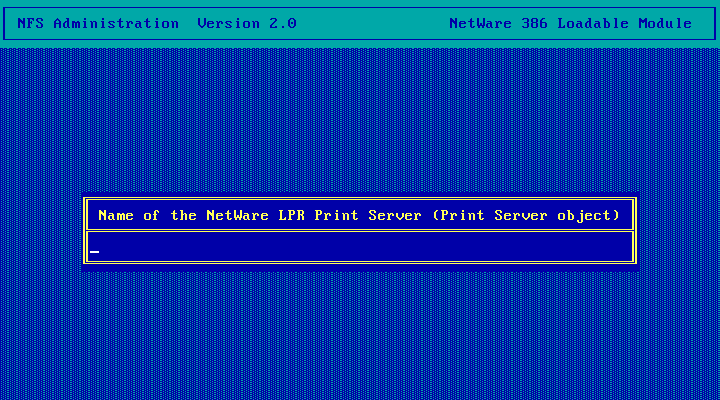
Then you get the list of configured UNIX printers. Hit insert to add one and you'll be asked a bunch of details. When done hit escape to conintue. I'm not setting up any so Escape it is...
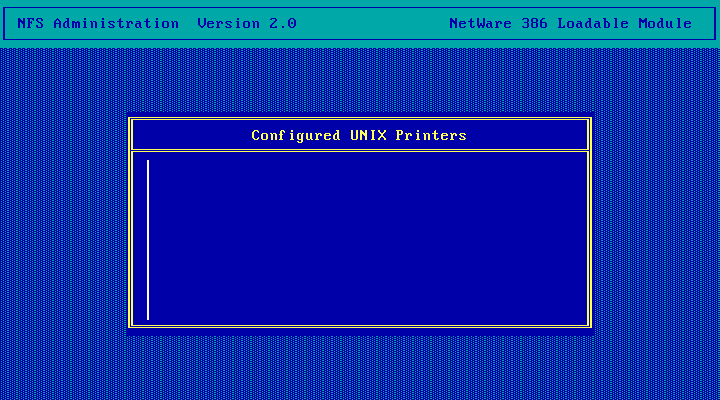
Done! Hit escape to continue.
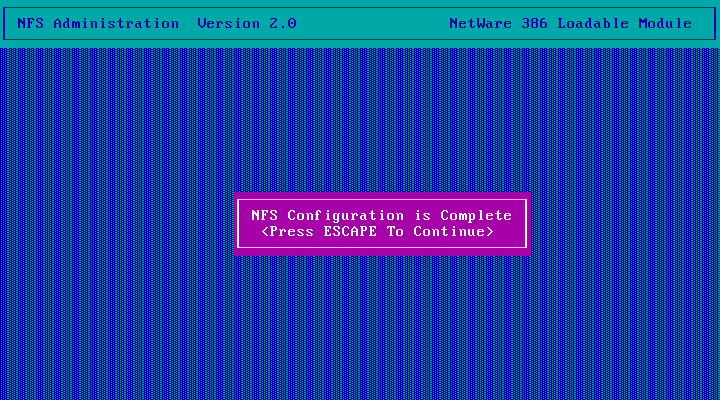
And choose Yes to exit.
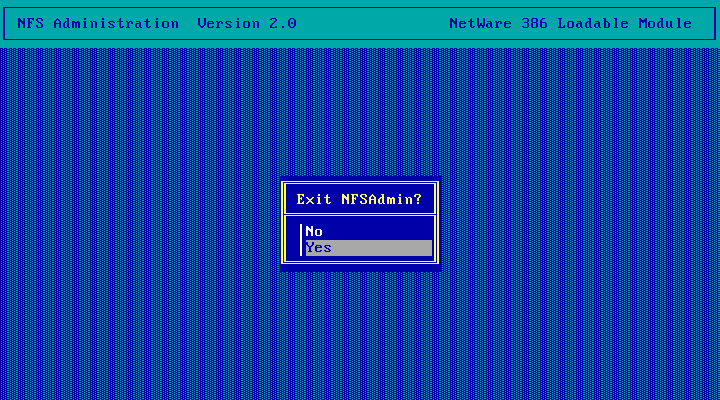
Now you've got to DOWN, EXIT and restart the server.
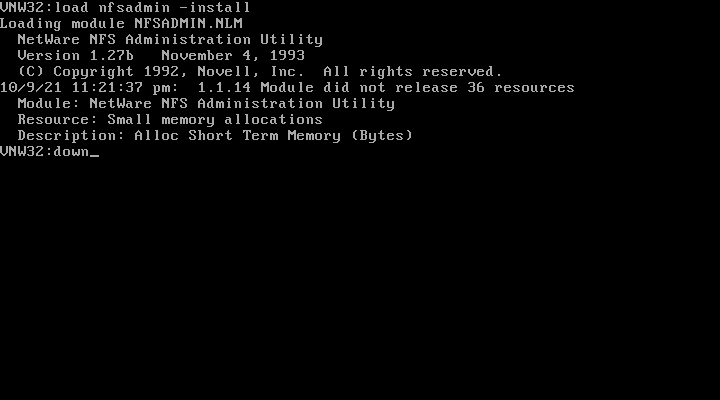
This time when the server booted back up intead of getting an error from the LRP print server I got this! Kind of makes me regret not setting up any printers. This time I've got RConsole setup so could switch back to the server console using that.
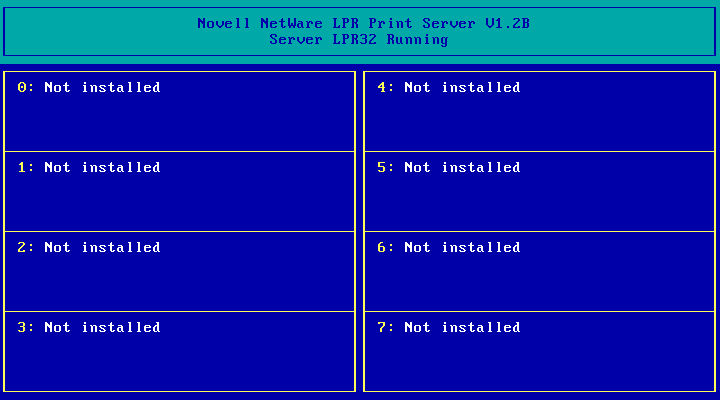
If you need to to make any further changes to the configuration you can just run NFSADMIN again. Without the -install parameter it will give you a menu where you can pick which files to edit. You can also see a list of connected clients and other statistics from there.
Installing the latest patch
There is a patch available for NFS 1.2C - NFS193.EXE. My copy of the NFS+NFS Gateway bundle came with the update (as well as the latest NFS Gateway 1.2 update) on a floppy disk. I'm going to install the update now as its got a few fixes that are probably worth having.
First step is on a DOS workstation. I'm logged in as supervisor and I've got the update disk in drive A.
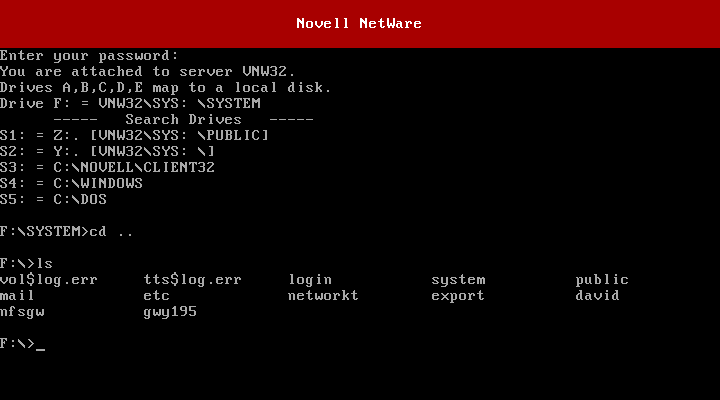
Create a new directory on the SYS: volume nfs1 and copy nfs193.exe into it.
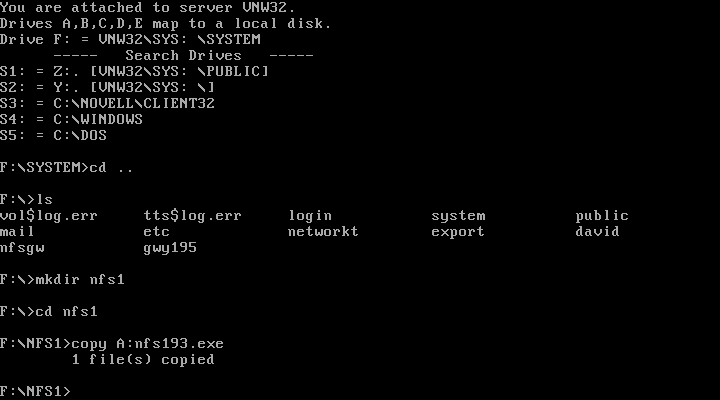
Run nfs193.exe. At the prompt type Y and hit enter.
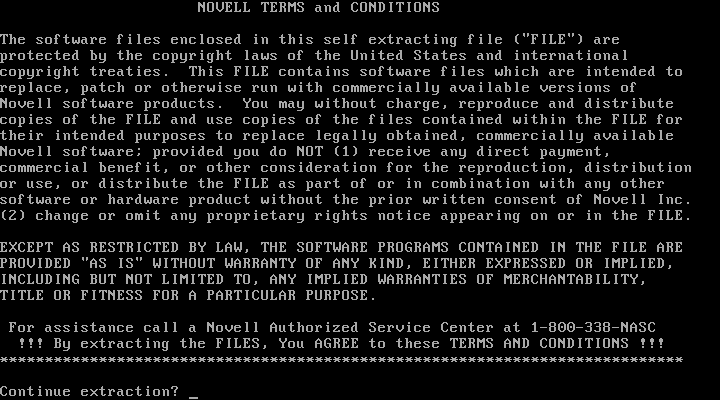
Files are extracted. Thats all we need the DOS workstation for.

Over on the server console, run UNISTOP to unload NFS and then LOAD INSTALL
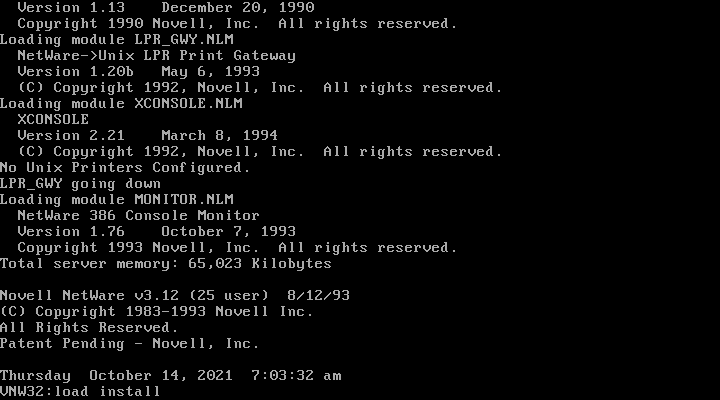
Choose Product Options
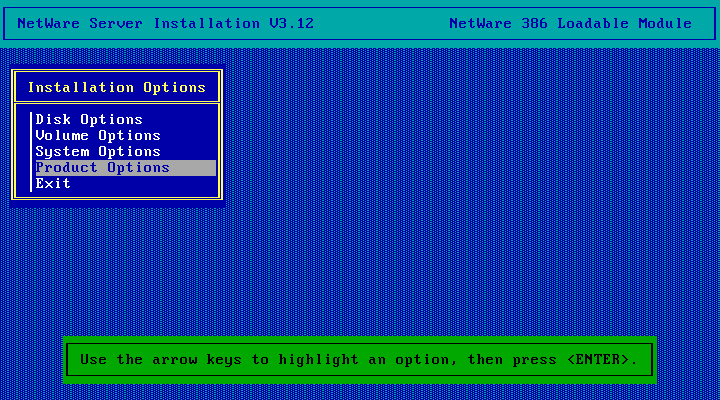
Press the insert key.
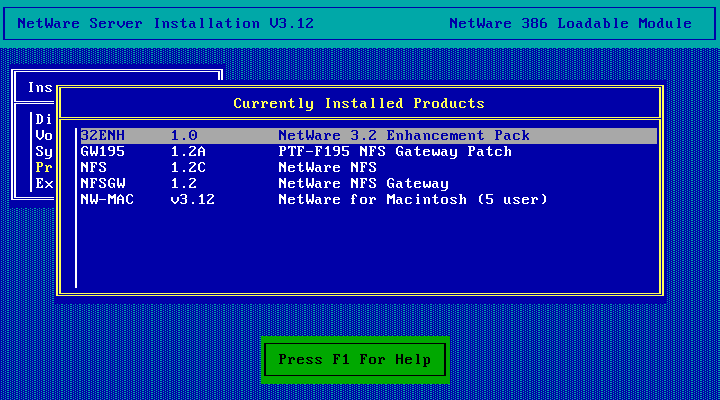
And enter the path SYS:NFS1 then press enter.
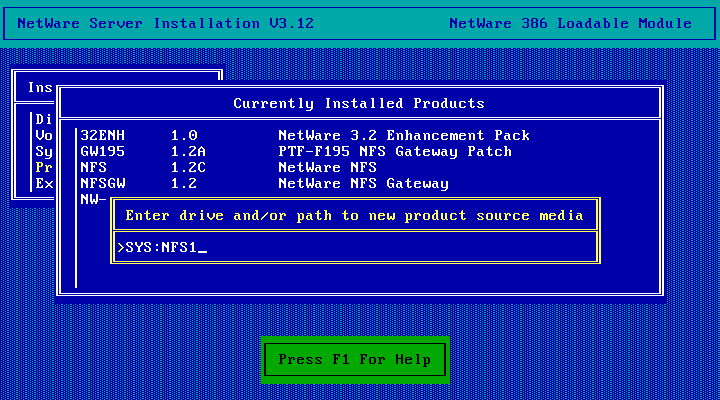
The patch is installed! Press escape.
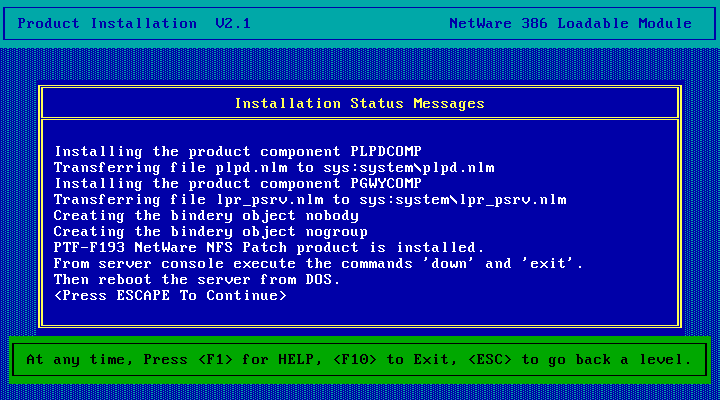
There is the patch! Press escape twice and choose yes to exit INSTALL.NLM then DOWN the server and EXIT back to DOS, then restart NetWare.
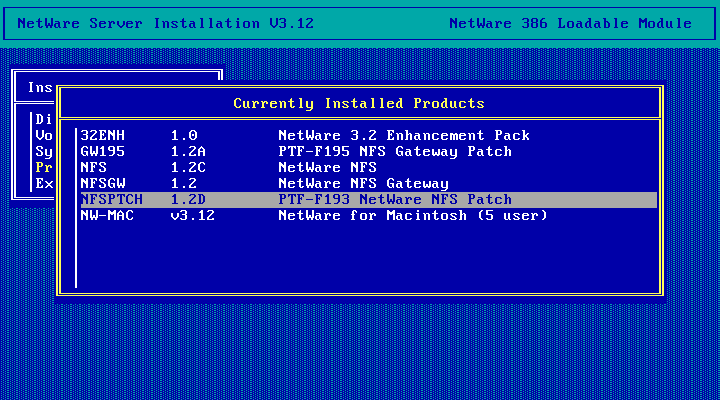
Trying it out: From Windows
For my first test I'm going to try and connect to the NetWare NFS server from a windows PC (LAPTOP-TBIBQL8D, 10.0.1.200) using this NFS Client App
These are the connection details. I'm connecting as my david user account with UID 1000:

Server has been added but not actually connected yet - have to click that connect button towards the right.

Connected! The Remote point dropdown in the middle shows my one NFS export already selected.

So I dragged nwdsk340.exe from the left panel (local) to the right panel (NFS) and it was uploaded to the netware server

Here is the result:

And here is the result on a DOS workstation:

Here it is on Windows 95
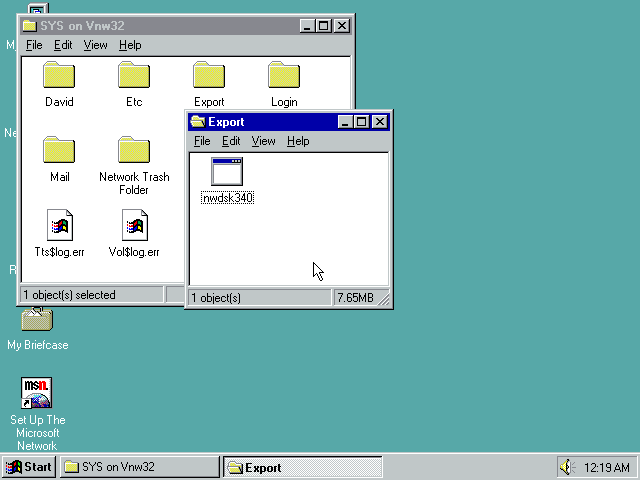
File properties

Namespace is NFS as thats how the file got on there in the first place

File properties showing the various NFS groups

From FTP
Turns out NetWare NFS includes an FTP Server! I just logged in with my netware credentials. The netware FTP server is run via inetd so it only starts up and runs when there is an active connection. If the NFS namespace is available for a volume it accesses files using that, otherwise it uses the DOS namespace. The FTP server is probably actually a more useful feature of NetWare NFS than the actual NFS bits these days.

From Linux
On debian/ubuntu you've got to sudo apt install nfs-common to get the NFS client.
NetWare NFS 1.2C only speaks NFSv2 (this is a product from 1993 after all) so to mount the NFS export you've got to mount it with the -o v2 option like this:
sudo mount -t nfs -o v2 vnw32:/sys/export /mnt
Here is my NetWare NFS export on linux! NFSv2 doesn't support 64-bit file sizes (that was added in NFSv3) so file sizes are limited to 2GB.
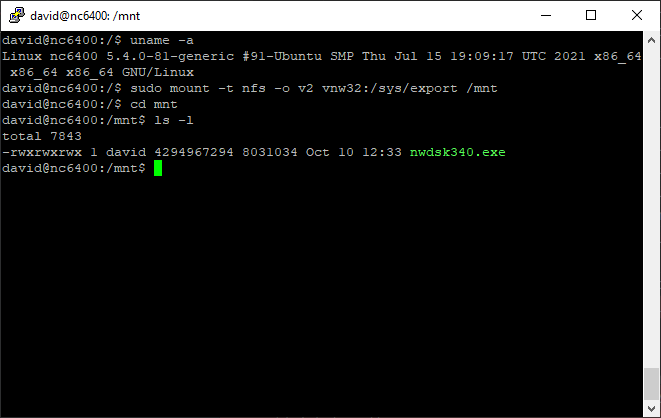
Disclaimer & Comments
I'm not a netware expert, don't have any of those fancy novell certifications and have never administred a netware network; I've just played with it at home occasionally since 2004 or so. Email me if you've got any suggestions or corrections for this page or any extra information you think is worth including here. My address is david at this websites domain name (without the www bit of course).